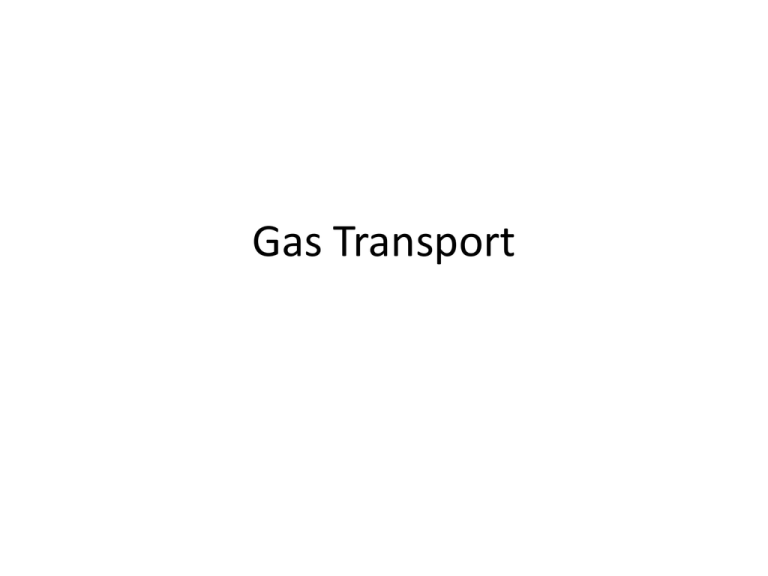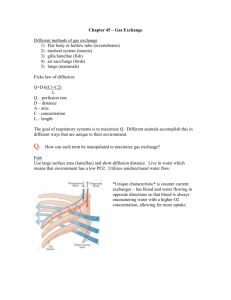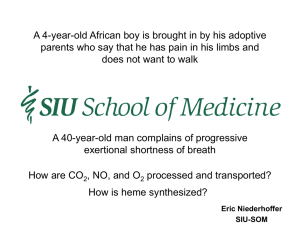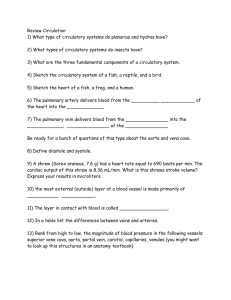Gas Transport
advertisement

Gas Transport Learning Objectives Covering the the transport of O2 and CO2 in the blood and tissue fluids. • Know how O2 and CO2 diffuse in pulmonary capillaries, systemic capillaries and in tissues. • Understand and be able to use the O2-hemoglobin dissociation curve. • Know the quantity of O2 and CO2 delivered by the blood. • Know what causes shifts in the O2-hemoglobin dissociation curve. • Know how CO2 is transported in the blood and understand the Haldane Effect. Movement of Gases • Gases move by diffusion, from areas of high partial pressure to areas of low partial pressure. - In the alveoli, O2 moves from the alveoli (high PO2) to the pulmonary blood (low PO2). - In the tissues, O2 moves from the blood (high PO2) to the tissues (low PO2). • How will CO2 diffuse? Diffusion of O2 in the Pulmonary Capillaries • What is the PO2 in the arterial end? 104 mm Hg – 40 mm Hg = 64 mm Hg. • What is the net direction of O2 diffusion in the arterial end? From the alveolar space into the blood. • How does the pulmonary anatomy allow the capillary blood to reach a PO2 of 104 mm Hg so quickly in the venous end? - Surface area (70 cm2 of respiratory membrane for 60-140 mL blood). - Thin respiratory membrane. - PO2. O2 Diffusion During Exercise • During exercise, the body may need 20 x more O2. • How does the exchange in the pulmonary capillaries meet this need? - Increased diffusing capacity (increased surface area and capillaries and improved VA/Q). - The blood reaches O2 saturation quickly (see previous slide). Changes in PO2 in Cardiovascular System Diffusion of O2 in the Systemic Capillaries and Tissues • The PO2 in the arterial blood is ~ 95 mm Hg and PO2 in the interstitial fluid is ~ 40 mm Hg. Thus, the PO2 ~ 55 mm Hg for the diffusion of O2 into the interstitial fluid. • The PO2 in the interstitial fluid is ~ 40 mm Hg and the PO2 in the tissues ~ 23 mm Hg. Thus, the PO2 ~ 17 mm Hg for the diffusion of O2 into the tissues. Blood Flow and Interstitial PO2 Diffusion of CO2 in the Systemic Capillaries and Tissues • Diffuses in the opposite direction as O2, because CO2 accumulates in the tissues as O2 is consumed. • Note: CO2 can diffuse ~ 20 x more rapidly than O2; so less differences in partial pressures are required. Diffusion of CO2 in the Pulmonary Capillaries • The PCO2 in the tissues ~ 46 mm Hg and the PCO2 in the interstitial fluid ~ 45 mm Hg. Thus, the PCO2 ~ 1 mm Hg for the diffusion of O2 into the interstitial fluid. • The PCO2 in the interstitial fluid ~ 45 mm Hg and the PCO2 in the arterial capillary blood ~ 40 mm Hg. Thus, the PCO2 ~ 5 mm Hg for the diffusion of O2 into the blood. Diffusion of CO2 in the Pulmonary Capillaries Blood Flow and the Interstitial PCO2 Transport of O2 by Hemoglobin • Nearly all the O2 (~ 97%) is transported in the blood by hemoglobin. • One hemoglobin molecule contains 4 heme prosthetic groups. • One hemoglobin molecule can carry 4 O2 molecules. O2-Hemoglobin Dissociation Curve Amount of O2 Carried by Hemoglobin (Volumes) • In 100 ml of blood, contains ~ 15 g of hemoglobin. • Each gram of hemoglobin can carry a maximum of 1.34 ml of O2. • Thus, 100 ml of blood can carry a maximum of 20 ml of O2 (15 x 1.34). Quantity of O2 Released to Systemic Tissues • At 97% hemoglobin saturation (arterial), 100 ml of blood carries ~ 19.4 ml O2. • At 75% saturation (venous), 100 ml of blood carries ~ 14.4 ml O2. • Thus, 100 ml of blood delivers ~ 5 ml of O2 under normal circumstances. • During exercise, 100 ml of blood can deliver ~ 15 ml O2. O2 Delivery During Exercise • During exercise, 100 ml of blood can deliver ~ 15 ml of O2 (3-fold increase from normal). • What happens to cardiac output during exercise? • During exercise, the cardiac output increases 6- to 7fold. • Thus, by increasing O2 transport and cardiac output, there can be a 20-fold increase in O2 delivery to tissues during exercise. Using the O2-Hemoglobin Dissociation Curve • The normal PO2 of the alveoli is 104 mm Hg. This results in a hemoglobin saturation of 97%. • What happens to hemoglobin saturation if the alveolar PO2 drops to 60 mm Hg, while climbing a mountain? The hemoglobin saturation only drops to 89%. • The venous blood PO2 only needs to drop to 35 mm Hg (from 40) for 5 ml of O2 per 100 ml to be delivered Shifts in the O2-Hemogobin Dissociation Curve • Increases in H+, CO2, and temperature shift the curve to the right. • This enhances the release of O2 from hemoglobin and is called the Bohr Effect. • In tissues, the high CO2 increases the [H+] (recall blood acid/base reactions involving bicarbonate). Causing the extra release of O2. • In the lungs, the removal of CO2 decreases the [H+]. This increases the binding of O2 to hemoglobin. • What happens to H+, CO2, and temperature in exercising muscle? Transport of CO2 in the Blood • Under normal conditions, the blood delivers ~ 4 ml of CO2 from the tissues to the lungs in each 100 ml of blood. • Why only 4 ml of CO2 per 100 ml if the blood delivers 5 ml of O2 per 100 ml? For carbohydrate metabolism, 1 molecule of O2 is formed for each CO2 consumed. When fats are metabolized, some of the O2 combines with H+ atoms from the fat to form H2O. Transport of CO2 in the Blood • Most of the CO2 in RBCs reacts with H2O, forming carbonic acid, which dissociates to H+ and bicarbonate ion. Transport of Bicarbonate to the Plasma • Many of the bicarbonate ions are transported out of the RBC in exchange for Cl- by the bicarbonate-chloride carrier protein. CO2 and Hemoglobin • Some CO2 combines with hemoglobin forming carbaminohemoglobin (CO2HbB). • In the lungs, the CO2 is released from CO2HbB. • Hemoglobin also binds the H+ released from the dissociation of carbonic acid. This helps buffer the pH of the RBC. Release of bound CO2 in the Lungs • How does the CO2 that combined with H2O and hemoglobin get released in the lungs? Binding of O2 to hemoglobin tends to displace CO2 from the blood. This is called the Haldane Effect. Haldane Effect • The binding of O2 to carbaminohemoglobin promotes its conversion to hemoglobin and CO2. • The binding of O2 to hemoglobin causes the release of a H+ ion. The H+ ion can then combine with bicarbonate ion to form carbonic acid, which then dissociates to CO2 and H2O. CO2 and Blood pH • What happens to the blood pH if CO2 becomes elevated? - It drops, because more carbonic acid is formed. - Normally, the pH of arterial blood is 7.41 and that of venous blood is 7.37 (0.04 difference). - During exercise, the pH of venous blood can drop by 0.5 units.







